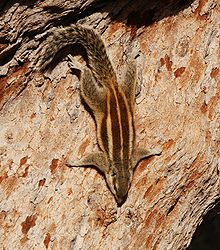- Northern Palm Squirrel
-
Northern Palm Squirrel 
Northern Palm Squirrel in Delhi, northern India Conservation status Scientific classification Kingdom: Animalia Phylum: Chordata Class: Mammalia Order: Rodentia Family: Sciuridae Genus: Funambulus Subgenus: Prasadsciurus
Moore & Tate, 1965[2]Species: F. pennantii Binomial name Funambulus pennantii
Wroughton, 1905[3]Subspecies[4] - F. p. pennantii
- F. p. argentescens
The Northern Palm Squirrel (Funambulus pennantii) also called the Five-striped Palm Squirrel is a species of rodent in the Sciuridae family.[5]
Distribution
It is found in the Andaman Islands, Nicobar Islands (introduced), India (in Andhra Pradesh, Assam, Bihar, Chattisgarh, Delhi, Uttaranchal, Punjab, Gujarat, Haryana, Jharkhand, Karnataka, Madhya Pradesh, Maharashtra, Orissa, Rajasthan, Sikkim, Uttar Pradesh and West Bengal), Nepal, Bangladesh, Pakistan and Iran. In India, it is fairly common in urban areas, even in large cities like Delhi & Kolkata. Two subspecies Funambulus pennantii argentescens and Funambulus pennantii lutescens were suggested by Wroughton in addition to the nominate race, however, more recent workers do not make this distinction. Thorington and Hoffman in Wilson and Reeder (2005) listed only two subspecies. Funambulus pennantii pennantii and Funambulus pennantii argentescens. However, Ghose et al (2004) described two additional subspecies viz: F. pennantii chhattisgarhi (Distribution : Eastern part of Maharashtra, Madhya Pradesh, Orissa, West Bengal and Bihar) and F. pennantii gangutrianus (Distribution : West Bengal, Madhya Pradesh, Uttar Pradesh and Nepal). But Talmale (2007) treated the Maharashtra populations as Funambulus pennantii pennantii only due to the overlapping in measurements and colour variations observed in the specimens from Maharashtra populations.
(References: (1) Ghose, R. K., Mandal, A. K. and Ghose, P. S. 2004. A contribution to the taxonomy of Indian five striped squirrel Funambulus pennanti, Wroughton), with description of two new subspecies. Rec. zool. Surv. India, 102 (3-4) : 89 – 103 and (2) Talmale, S. S. 2007. Studies on Small Mammal Diversity in Maharashtra State. Ph.D. Thesis submitted to University of Pune, Maharashtra State, India).
[6][7] It has also been introduced to Australia.In India the southern boundary is not clearly identified and recent records suggest that the southern boundary of the species may extend as far as Madanapalli.
The southern boundary on western ghats side clearly extends up to some localities, including Dhawar, Mysore etc., in Karnataka state (Pradhan and Kurup, 2001).
(Reference: Pradhan, M.S. and Kurup, G.U. 2001. Mammalia IN Fauna of Nilgiri Biosphere Reserve. Fauna of conservation Area Series 11. Publ: Director, Zoological Survey of India, Kolkata: 311-330.)
References
- ^ Nameer, P. O. & Molur, S. (2008). Funambulus pennantii. In: IUCN 2008. IUCN Red List of Threatened Species. Downloaded on 6 January 2009.
- ^ Moore, J.C. and G.H.H. Tate (1965). "A study of the diurnal squirrels, Sciurinae, of the Indian and Indo-Chinese subregions". Fieldiana Zoology 48: 1–351.
- ^ Wroughton, R.C. (1905). "The common striped palm squirrel". Journal of the Bombay Natural History Society 16: 406–413.
- ^ Thorington, R.W., Jr.; Hoffmann, R.S. (2005). "Family Sciuridae". In Wilson, D.E.; Reeder, D.M. Mammal Species of the World: a taxonomic and geographic reference (3rd ed.). The Johns Hopkins University Press. pp. 754–818. ISBN 0-8018-8221-4. OCLC 26158608. http://www.bucknell.edu/msw3/browse.asp?s=y&id=12400001.
- ^ Thorington, R. W. Jr. and R. S. Hoffman (2005). Family Sciuridae. Pp. 754-818 in Mammal Species of the World a Taxonomic and Geographic Reference. D. E. Wilson and D. M. Reeder eds.. Johns Hopkins University Press, Baltimore.
- ^ Ellerman, J.R. (1961). The fauna of India including Pakistan, Burma and Ceylon: Mammalia, Rodentia. Volume 3 (in 2 parts). Vol. 1: 1-482 & Vol. 2: 483-884. Second ed.. Zoological Survey of India, Calcutta.
- ^ Srinivasulu C., S. Chakraborty and M.S. Pradhan. "Checklist of the Sciurids (Mammalia:Rodentia:Sciuridae)" (PDF). Zoos' Print Journal 19 (2): 1351–1360. http://www.zoosprint.org/ZooPrintJournal/2004/February/1351-1360.pdf.
- ^ Santharam, V. (2007). "Five-striped Palm Squirrel (Funambulus pennantii) in Rishi Valley, Chittoor district, Andhra Pradesh". J. Bombay Nat. Hist. Soc. 104 (2): 202.
Categories:- IUCN Red List least concern species
- Funambulus
- Mammals of Pakistan
- Fauna of Iran
- Rodents of India
- Mammals of Nepal
- Mammals of Bangladesh
- Squirrel stubs
Wikimedia Foundation. 2010.


